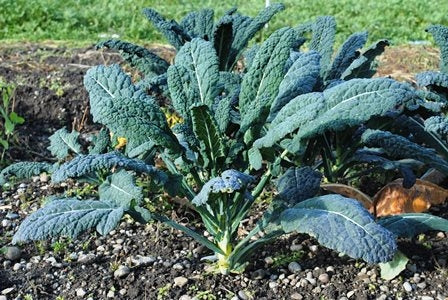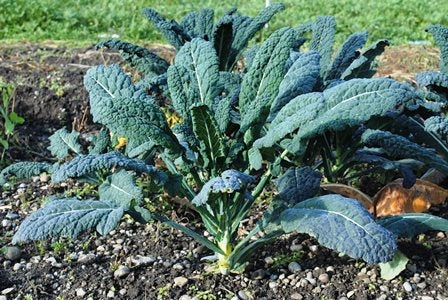TUSCAN BLACK CURLY CABBAGE - ko39
Have a question?

TUSCAN BLACK CURLY CABBAGE - ko39
Dettagli
Scientific name: Brassica oleracea L. var. acephala sabellica
Family: Cruciferae – Brassicaceae
Brief history and botanical notes on the plant
Frizzy black cabbage or Tuscan cabbage (Brassica oleracea var. acephala sabellica) belongs to the Cruciferae family – Brassicaceae, tribe: Brassiceae –. Species: Brassica oleracea L. var. acephala sabellica: as can be understood from the name of the variety, unlike other cabbages, it does not produce a compact head, but develops long leaves.
It has an erect stem, up to 1 meter tall, with dark green, wrinkled and blistered leaves.
It is a plant of very ancient origins cultivated mainly in Tuscany, in the preparation of the famous "ribollita".
The edible part is made up of the leaves, made more tender and tasty by the first frosts, although it can be grown and consumed practically all year round.

Needs
Black cabbage is a plant that is particularly resistant to cold and frost, from which it often benefits as it can make it more tender, improving its flavour.
It is characterized by notable resistance to cold (down to -10° C).
It adapts well to all types of soil, as long as they are well drained. Cultivation in deep, aerated and fresh soil, well endowed with organic substance and with a pH around neutral is ideal.
Sowing and transplanting times
Seedlings grown in the nursery in honeycomb containers or with bare roots (sowing between April and May) are used and subsequently transplanted after 40-50 days, when the seedlings have produced their fifth leaflet. Excellent rotation with legumes.
The spacings are 70-80 cm between the rows and 50-60 cm on the row.
Processing
They require deep tillage of the soil to facilitate the development of the root system.
Fertilization
The crop benefits considerably from organic fertilization.
Products
The leaves are marketed, the upper ones and the young shoots that form on the stem and branches are used.
Cultural care
Control of wild herbs can be achieved with weeding, mulching and localized irrigation as well as correct crop rotation.
It is important to eliminate crop residues at the end of the cycle.
Irrigation
The crop requires irrigation upon transplanting and in the initial growth phase, with frequent but moderate interventions.
Adversity
Black cabbage is not particularly susceptible to fungal diseases and among animal parasites only cabbage can constitute a problem sufficient to justify interventions.
Among the fungal diseases we remember Alternariosis (Alternaria brassicae), Cruciferous hernia (Plasmodiophora brassicae), basal rot (Sclerotinia spp., Rhizoctonia solani, Phoma lingam), powdery mildew (caused by Erysiphe cruciferarum) and downy mildew (Peronospora brassicae, Peronospora parasitica). Also susceptible to some bacteria (Xanthomonas campestris, Erwinia carotovora).
The most important animal parasites are aphids (Myzus persicae, Brevicoryne brassicae), noctules, cabbage flies (Mamestra brassicae, Mamestra oleracea, Pieris brassicae), wire weevils (Agriotes spp.), altica (Phyllotreta spp.), weevils (Baris spp., Ceuthorrhyncus spp.) and the cabbage fly (Delia radicum).
Defense products
Downy mildew can be prevented by spraying with horsetail decoction.
Hernia of cruciferous plants and numerous basal rots and bacteriosis are strongly limited by correct rotations (avoid the cultivation of any cruciferous plant for 3-4 years on the same plot), by the distribution of lithotamnium on the soil before transplanting and by spraying with horsetail decoction .
Bacillus thuringiensis and neem oil can be used to control night moths and cabbage flies.
Altica can be a serious problem especially in the case of compact and dry soil; it can be contained in small vegetable gardens with broom branches and by dusting the vegetation with lithotamnium and bentonite. In case of strong attacks, use pyrethrum.
The control of the cabbage fly is above all preventive and essentially consists in the destruction of vegetation residues, possibly also removing the surrounding earth. Intra-sowing, for example with clover, hinders oviposition.
Production and collection
The production cycle of black cabbage is quite variable and depends to a large extent on the more or less early variety that you decide to grow, but generally it is not harvested for at least a hundred days. The average production per square meter is around 2-2.5 kg.
Nutritional values
Black cabbage, like other cabbages, is very rich in vitamin A, vitamin C, vitamin K (important for blood clotting) and mineral elements such as potassium, phosphorus, iron, calcium, sulfur (also responsible for the characteristic perceptible odor during cooking). It is low in calories. It should be considered protective against some tumors, especially those of the digestive and urinary tract. The decoction of cabbage leaves helps fight bronchitis and asthma as well as diseases of the gastrodigestive system. The cooking water is rich in sulfur and is used to treat eczema and inflammation. Cabbage juice is also very useful for fighting constipation.
Some scholars maintain that the unique mix of its nutrients, in addition to having effects on health, also helps to counteract the sadness typical of the change of season.
Family and variety
The Nero Lancinato di Toscana variety includes early and normal/late selections.
Biodynamics
In addition to the spraying of spray preparations at the plant and in production, the supply of well-composted organic substance via biodynamic heap allows you to limit imbalances in growth.
It is advisable to weed the propagation material with soil mixed with cornoletame 500 or with diluted biodynamic log paste or simply with a clayey mixture.
USE OF THE BIODYNAMIC CALENDAR
To preserve quality and shelf life, harvest the leaves on days.


